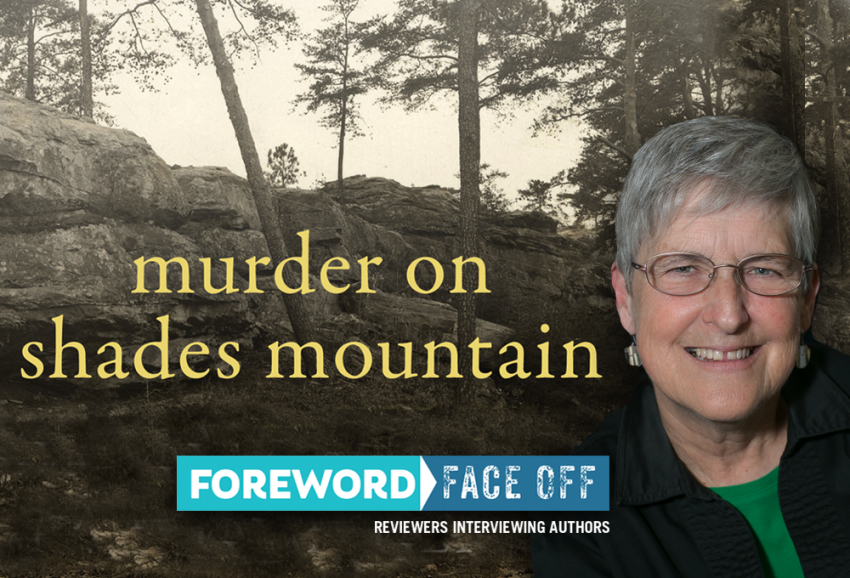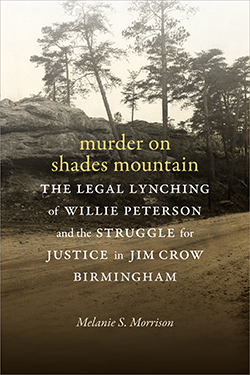Reviewer Talks Racism with Melanie Morrison, Author of Murder on Shades Mountain

Reviewer Karl Helicher Interviews Melanie Morrison, Author of Murder on Shades Mountain.
Of all the racial divisions in this country, one of the most enduring and discouraging is the percentage of white Americans who don’t see racism as a problem, and, in fact, believe society does TOO much to help African Americans. Somehow they dismiss racial profiling, high incarceration rates for black men, the deplorable state of many inner-city public schools, and other legacies of eras gone by when racism was front and center and all but legal. Somehow they dismiss the recent rise in white supremacy.
While pulling our hair out in frustration, we can only conclude that the United States has done a disgraceful job educating students on the history of racism.

Of the infinite stories of injustice in the American South, one of the most egregious features Willie Peterson, a black man falsely accused of murdering two affluent white girls in the early 1930s in Birmingham, Alabama. Today’s Face Off features Melanie Morrison, the author of Murder on Shades Mountain, a compelling investigation of the Peterson case enhanced by much-needed historical context. In his Foreword Reviews review of the book, Karl Helicher writes, “Morrison’s is a deeply researched account of the shooting [of the girls], the ensuing trials, and the fight between the NAACP and the American Communist Party for the allegiance of black Americans in Birmingham and the nation. … Audiences will be enthralled and angered by this all-too-familiar account of a criminal justice system that was and remains biased against black Americans.”
Karl and Melanie’s conversation represents exactly the sort of truth-telling this country needs to embrace as our racial enlightenment unfolds. You’ll find Special Features and Featured Reviews at the end.
This terrific book reveals one of the most significant lynching incidents of which most readers never heard. How did you become aware of the Peterson trial, and why don’t we know more about it?
I learned about the trials of Willie Peterson from my father who was born and raised in Birmingham. He was only thirteen years old when the murders on Shades Mountain occurred, but this case proved to be a momentous turning point in my father’s young life. He often told the story later to describe the gross inequities that black people suffered in Jim Crow Birmingham.
When three white women were brutally attacked on a secluded mountain ridge overlooking the city of Birmingham in the summer of 1931, it was a huge story. When the sole survivor, Nell Williams, said a black man had held the women captive for four hours before shooting them and disappearing into the woods, a reign of terror was unleashed on the black community. Six weeks later, when Nell Williams identified Willie Peterson as the assailant who killed her sister, Augusta, and friend, Jennie Wood, this story was spread across the front page of every Birmingham newspaper. The conviction and sentencing of Willie Peterson also received widespread coverage in black newspapers throughout the United States because the trial was rife with judicial bias and misconduct.
The legal lynching of Willie Peterson vividly demonstrates how courtrooms in Jim Crow Alabama could function like lynch mobs when the defendant was black and the victims of the alleged perpetrator were white women. Despite the fact that Peterson bore little resemblance to the description originally given by Nell Williams, and despite the fact that her story kept changing over time, Willie Peterson was sentenced to die in the electric chair.
The struggle to free Willie Peterson provides a window into the social and economic forces at work in the early 1930s. The NAACP and the Communist Party vied for leadership in defending Peterson. Although the NAACP eventually took the lead, the Communist Party’s legal arm—the International Labor Defense (ILD)—continued to generate support for Peterson in Birmingham’s poor and working class black communities.
Over the years, the Peterson case has been noted by historians and legal scholars, but given its significance, I was surprised that no one had undertaken an exhaustive investigation of this case. The more I learned about the case and the historical context surrounding it, the more I felt compelled to do just that.
Describe your relationship with your father. How did he inspire you and what connections did he have to the Peterson case?
My father was a pastor, but the work of dismantling racism and white supremacy was his deepest calling. In the churches he served, he often declared from the pulpit: “To love God, you must work for justice, and justice cannot be realized in this country until racism is eradicated!” He didn’t just talk about the evils of systemic racism, he and my mother were actively involved in organizations that sought to address the racial disparities in housing, education, health care, and the judicial system.
My passion for racial justice and my work as an antiracism educator are legacies I inherited from my father. One of the core stories that seeded this passion was my father’s telling of the unjust conviction of Willie Peterson.
My father grew up in the Mountain Brook section of Birmingham, the only son of a wealthy white entrepreneur. When he was fifteen years old, he fell in love with Genevieve Williams, the younger sister of Nell and Augusta Williams. Just months after he was smitten, the defense of Willie Peterson was once again in the news. The NAACP asked several prominent white leaders to write Governor Miller imploring him to commute Peterson’s sentence to life imprisonment. One of those leaders was my father’s pastor, Henry Edmonds—a man my father deeply admired as a mentor. When the governor commuted Peterson’s death sentence in March 1934, citing “grave doubt as to his guilt,” my father believed that Edmonds had played the decisive role.
Torn by conflicting loyalties to his girlfriend and his mentor, my father’s insular white world began to come apart. He became obsessed with the possibility that Willie Peterson had been wrongly convicted and—much to the surprise of his family and friends—he ended the relationship with Genevieve.
Two years after my father’s death in 2006, I stumbled upon a book and an article that described the Shades Mountain murders. Much of what my father had told us was corroborated, but I also discovered gaping holes in my father’s story. As a teenager living in his insular white enclave of Mountain Brook, he didn’t know about the reign of terror carried out on the black community or the black-led campaigns to free Willie Peterson.
Discovering these holes in my father’s story, I made my first trip to the Birmingham archives, compelled to learn more about these events, as much by what my father did not tell me as what he did.
Tell us about Willie Peterson. He was a very unlikely person to commit a murder. Why did so many people want to see him framed and executed? What does this tell us about the times?
At the time of his arrest, Willie Peterson was an unemployed miner disabled by tuberculosis. Weighing only 125 pounds, having no criminal record, and most days unable to be up and around for more than a few hours at a time, it is highly improbable that Willie Peterson would have had the physical capacity to commit the crimes that Nell Williams described. As my book reveals, most of the arresting officers and legal authorities that had contact with Peterson later testified that they had always harbored doubts that he was the assailant. They kept those doubts to themselves, however, and abruptly ended the manhunt as soon as Nell Williams identified Willie Peterson as the assailant. They let the scapegoating of Willie Peterson unfold because they didn’t want to assail the reputation of a white woman or imply that she might be lying.
To me, the most fascinating aspect of the book was its comparison to the much better known Scottsboro Boys case. What are some of the similarities and differences between these cases?
Yes, the case of the Scottsboro Boys played a critically important role in what transpired after the murders on Shades Mountain. The trials of the nine young black men in Scottsboro, Alabama, accused of raping two white women had many in Birmingham’s white community on edge, fearing that something as horrific might befall Birmingham. The fact that the Communist Party was managing the defense of the Scottsboro Boys and shining a light on Jim Crow injustice was another source of fear and resentment among Birmingham’s white population.
Given the backdrop of the Scottsboro trials, it is not surprising that rumors of communist conspiracy fueled the manhunt for the Shades Mountain assailant. The attack on Shades Mountain became the pretext for intensifying efforts to arrest anyone suspected of being a communist.
In many ways the violence perpetrated on Shades Mountain was more frightening to Birmingham’s white elite than the crime being tried in Scottsboro. Unlike the victims in the Scottsboro case, the victims on Shades Mountain were from prominent white families.
Although the ILD sought to gain control of the Peterson case, the NAACP officials convinced Willie Peterson’s spouse, Henrietta, to retain their lawyers. With the financial support of the national offices, local NAACP leaders spearheaded the campaign to free Willie Peterson.
What lessons would you like readers to take from the book? Why is it important now?
The injustice that Willie Peterson suffered was all too prevalent in Jim Crow Birmingham. His case is significant, but sadly, not exceptional. The history of Jim Crow racism has not been adequately taught in our country’s public schools. To understand the alarming rise of white supremacy we are experiencing today, as well as the continuing realities of racial profiling and the criminalization of black men, its is essential that we understand the legacies of Jim Crow racism. These legacies continue to distort white imaginations and fuel racial disparities in arrests and sentencing.
Researching and writing this book has also taught me that those of us who are white must always critically examine the family stories we have inherited, even those that have inspired our passion for justice. For years, I retold the Shades Mountain story as my father had described it, not knowing I was telling a truncated, white-centric story that rendered invisible the black-led resistance in Birmingham in the 1930s.
Please describe the legacy of the Peterson trial to the 1960s civil rights movement and to the current Black Lives Matter?
Just as the history of Jim Crow injustice has not been adequately taught in America’s public schools, children and youth today learn very little about the manifold organizations, movements, and uprisings—led by people of color—that resisted racism in every region and era of this country’s history. When the struggle for justice in Jim Crow Birmingham is remembered, it is images and events from the 1960s that most often come to mind. But the civil rights movement was not born in the 1960s or the preceding decade. It is centuries old and the 1930s are rife with historical antecedents to the movements and protests of the 1950s and 1960s.
As I learned about the black-led resistance to legal lynching in Jim Crow Birmingham, I was learning about the courageous predecessors of present-day movements like Black Lives Matter that demand an end to racial profiling, police brutality, and the criminalization of black men.
Karl Helicher
